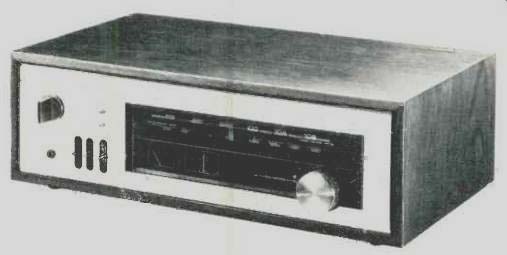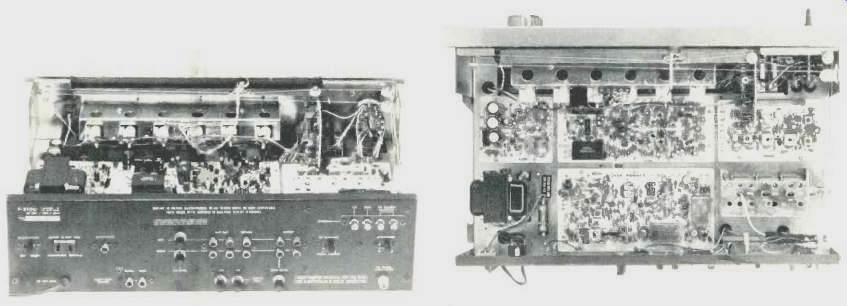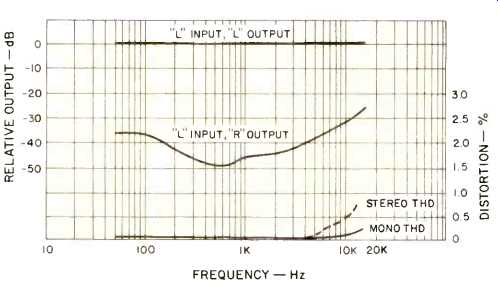
MANUFACTURER'S SPECIFICATIONS
FM Section
IHF Sensitivity: 2.2 µV.
Sensitivity for 50 dB S/N: 2.2 µV.
S/N: 75 dB.
THD: Mono, 0.1%; Stereo, 0.12%.
Selectivity: 70 dB. I.F.
Rejection: 99 dB.
Image Rejection: 90 dB.
Spurious Rejection: 95 dB.
AM Suppression: 55 dB.
Capture Ratio: 1.5 dB.
Stereo Separation: 1 kHz, 45 dB; 100 Hz to 10 kHz, 30 dB.
Muting Threshold: 5µV, variable.
Stereo Threshold: 5µV.
Frequency Response: 20 Hz to 15,000 Hz, +0.2,-1.5 dB.
AM Section IHF Sensitivity: 14 µV.
S/N: 50 dB. I.F. Rejection: 85 dB.
Image Rejection: 80 dB. THD: 0.5%.
Dolby and Output Characteristics
Output Level: 1.8 V for 1100% modulation. "0" Dolby Level: 900 mV.
AM Output Level: 1.5 volts for 100% modulation.
Dolby Tape Play THD: Less than 0.1% from 20 Hz to 20 kHz, at 0 Dolby level.
Dolby Tape Play S/N: 80 dB.
General Specifications
Dimensions: 19 in. W by E+ in. H by 11 in. D.
Weight: 20 lbs.
Suggested Retail Price: $595.00.
Having visited Japan on several occasions, I can attest to the popularity of Lux Corp. products with Japanese audio enthusiasts. The better audio shops which I visited invariably used a Lux amplifier as a "standard of comparison" or for playing special program material which they wanted to demonstrate. Some years ago, Lux teamed up with an American-based company and attempted to distribute a special line of products intended for the more general audio market (as opposed to the top-performing and top-priced units the company sells in its own domestic market, as well as in Europe and Asia). More recently, Lux formed an American company, which is called Lux Audio of America, Ltd., and the Model T-310 is the first product we have had a chance to measure and test from this new company. As we understand it, the new company plans to market the very same products which are so acclaimed in Lux's home market (except for modification to U.S. voltages and frequencies used in FM). Based on our measurements and use of this first product, we expect that Lux audio equipment will become as highly regarded in this country as it is in Japan.
The Lux T-310 tuner, like all of the company's components, comes complete in a rosewood cabinet which compliments the rich looking, bronze-gold colored front panel beautifully. A large dial at the right of the panel has a linearly calibrated FM dial, and AM dial scale, and an illuminated dial pointer. Below the scales and to the left are a signal-strength meter (which also doubles as a calibrating meter for the Dolby noise reduction circuitry that's built in) and a center-of-channel FM tuning meter. At the right are two jewel-lights which tell the user whether AM or FM has been selected and at the extreme right of the dial scales is a stereo indicator light in the form of an inverted candelabra. A massive tuning knob is coupled to an effective flywheel at the lower right of the panel.

Fig. 1--Rear panel.
Fig. 2--Interior view.
The left section of the panel includes a push-button power on/off switch, a selector switch, three three-position toggle switches, and a pair of momentary push button switches. The selector switch has positions for AM, FM/Stereo, stereo-only, and mono. The first of the three toggle levers selects variable or fixed interstation muting or turns off the muting entirely. Interestingly, this is the first tuner we have encountered which also provides interstation muting on AM. The second lever introduces a noise-filter circuit for either AM or FM, while the last lever switch is used to selectively decode Dolbyized FM broadcasts or to make the entire Dolby circuitry available for use with tape recorders in recording and playback.
The rear panel of the T-310, shown in Fig. 1, resembles a preamplifier more than a tuner, and, in fact, in many ways this unit offers control features ordinarily found only in separate control preamplifiers. For example, there are fixed and variable main-output jacks (the latter controlled by an out put level control on the rear panel), dual pairs of tape-play back jacks intended for connection to tape-deck outputs and to the monitor jacks of an integrated amplifier, record-out jacks, and a four-channel detector output jack. Left and right Dolby calibration potentiometers are also accessible from the rear panel, as are threshold controls for both the AM and FM muting circuits. A de-emphasis switch selects 25 microsecond or 75 microsecond operation, the former value required for properly receiving Dolbyized FM transmissions in this country. Both the 300-ohm antenna inputs and the AM external antenna inputs are of the screw terminal type, whereas the 75-ohm FM antenna input is a co-axial connector. An antenna attenuator switch is also provided, for use in case of strong-signal overload. There are also multipath indicator jacks for connection to the horizontal and vertical inputs of an oscilloscope. A line fuse, a.c. receptacle, and dial area brightness switch complete the rear panel lay out. The built-in ferrite bar antenna is located inside the chassis and is therefore non-adjustable.
Figure 2 is a close-up photo of the internal layout of the chassis of the Lux T-310. Eight major circuit board modules are used in the design, including the sealed FM front-end which contains two dual-gate FETs (r.f. amplifier and mixer) and a four gang variable capacitor. The i.f. section utilizes four ICs and an input bi-polar transistor, plus a combination of solid-state i.f. filters and conventional interstage transformers. Included in this module is the elaborate AM and FM muting circuitry which not only senses signal strength but also analyzes noise content as well as center-of-channel tuning before turning on the audio signal when the mute circuitry is utilized. This sophisticated muting circuit alone uses 14 separate transistors. Stereo multiplex-decoding circuitry consists of a single IC followed by a low-pass filter to attenuate sub-carrier output products. The AM module consists of a separate r.f. amplifier stage (a 3-gang variable capacitor is used in this circuit) and three i.f. stages plus an amplified AGC circuit. A total of seven transistors are used in the AM section. Dolby circuitry is similar to that found in other, separate Dolby add-on units and is, of course, included under a licensing agreement from Dolby laboratories.
Lux elected to use discrete components as opposed to the "chips" which are now available for that purpose. A power-supply module, incorporating four transistors and two FETs for regulation, completes the circuit layout. Major components are clearly identified on each module, and workmanship and layout are such as to make servicing easy. Inter-wiring between major modules is neatly harnessed and dressed, and all modules seemed mechanically well anchored and impervious to damage from shipping or other rough handling.
Laboratory Measurements

Fig. 3-FM quieting and distortion characteristics.

Fig. 4-Separation and distortion versus frequency.
It would appear that Lux intends to be one of the more conservative audio makers when it comes to published specs, as most of our results were far superior to those claimed in the owner's manual. For example, best signal-to-noise ratio in mono read 78 dB-about as good as we are able to read with our Sound Technology FM Stereo Generator. Distortion in mono and stereo was the lowest we have ever read for any tuner at any price. It measured 0.033% in mono and 0.06% in stereo at mid frequencies, as shown in the graphic plots of Fig. 3. The 50-dB quieting mark in mono occurred at an input signal strength of only 2.0 microvolts (as against 2.2 µV claimed). IHF sensitivity measured exactly 1.7 µV as claimed. This corresponds to exactly 10 dBf, using the newly approved IHF standards which measure signal strength in terms of power rather than voltage. Ultimate quieting in stereo was an impressive 72 dB, and approximately 30 µV was required to reach that stereo quieting (35 dBf). The standard calibration of our graph in Fig. 4 (with respect to percentages of distortion) was just not sufficiently expanded to permit accurate plotting of THD over the audio range in mono and stereo. Specifically, mono THD was well below 0.1% from 30 Hz to 10 kHz. Stereo THD readings hovered around the 0.06% mark from 30 Hz to 4 kHz, increasing to 0.5% at 10 kHz, still unusually low. Best stereo separation of 48 dB was observed for a 400 Hz signal, and separation decreased to 38 dB at 50 Hz and to 31 dB at 10 kHz-well within published claims.
Lux's conservatism extends to some of the "lesser" FM specs as well. We measured a capture ratio of 1.2 dB, as opposed to the 1.5 dB claimed, and alternate channel selectivity turned out to be 76 dB as against 70 dB claimed. All rejection figures (image, i.f. and spurious) were in excess of 95 dB. Muting threshold was at 5µV in the fixed position of the muting switch, and it was variable from 3µV to 30 µV when the front panel switch was moved to variable mute. Stereo threshold (switching) occurred at an input signal strength of 4 µV (17.2 dBf) and was positive and instantaneous with no semi-stereo condition apparent.
We made just a few measurements of AM performance and obtained results that were entirely consistent with published claims, with the exception of distortion which bettered spec at 0.4% for 30% modulation.
Using our FM generator, we determined that "0" dB Dolby level (as read on the dual-purpose front panel meter) corresponded to an FM modulation level of around 45% in mono and around 40% in stereo (allowing for the 19 kHz pilot).
Listening and Use Tests
The Lux T-310 will really display its merits if you are fortunate enough to live in an area where some stations continue to practice good signal transmission and we were able to detect the tuner's superior noise-quieting characteristics and excellent sensitivity even in our listening tests, since these qualities are not dependent upon station studio practice. Proper de-emphasis and unerring frequency response were also quite evident-though it was clear from our listening tests that not all stations even take the pains to worry about these important parameters at the broadcast end.
From a functional point of view, the Lux T-310 is a wonderful tuner to use. The AM muting feature has to be heard to be believed. And, of course, if you own any kind of tape equipment (open reel or cassette) that lacks Dolby noise reduction, you pick up in the T-310 an "accessory" that generally sells for more than $100.00 when bought separately. In that connection, it should be noted that if the Dolby feature is not something you require (because you already own an outboard Dolby unit), another version of this tuner is available from Lux. The Model T-300 performs exactly the way the T-310 does, we are told, but does not include the Dolby feature and sells for $100.00 less than the T-310.
Since test reports are generally expected to come up with at least one criticism, we searched and searched and finally came up with one. The unit tested has the de-emphasis switch on the back of the unit, a mildly awkward place to get to in some installations, but the folks at Lux tell us that production has already been changed so that de-emphasis is automatically switched when the front panel switch is changed from FM to FM-Dolby. Properly chastened, we were (and are) ready to admit that Lux's first tuner entry in the U.S. market is a stunningly executed product that should appeal to the FM buff who seeks the finest FM reception available and has good enough broadcasters in his area to justify its incorporation into a top component system for home listening.
-Leonard Feldman
(Audio magazine, Jan. 1976)
Also see:
Lux Audio MB-3045 Power Amplifier (Equip. Profile, Nov. 1977)
Luxman LV-109 Integrated Amplifier (Sept. 1987)
= = = =